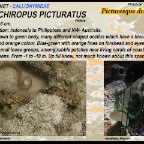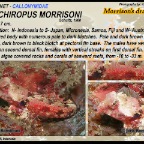Dragonets - Callionymidae
DRAGONETS - CALLIONYMIDAE
These small bottom-dwellers are easy to recognize because they have both protrusive mouth and eyes and both protrude out of their head. Their eyes are able to move separately in different directions and this helps them to look out for predators and food. Most of the species blend well into their surrounding even though some are very colorful. The males are bigger and have a larger first dorsal fin which they use to show-off during courtship, or when having rivals. The most famous of all is of course the very colorful mandarinfish or Synchiropus splendidus. All dragonets mate and spawn just after sunset.
Length: 6 cm.Distribution: from E- Africa to the Andaman Sea and Sumatra (Indonesia).Red with dark and light blotches and saddles. Pale snout and light blue spots on the head. Banded dorsal fin.Solitary or in small groups, on sand, algae covered rocks and between coral heads.From -5 to -20 m. Length: 6 cm.Distribution: Indonesia to S.W- Japan, Philippines, E- Caroline Is. and New Caledonia.For sure the most famous and beautiful dragonet. Orange body with a chaotic blue or green lined pattern. Bright yellow lines and spots on lower head, bright red eye.They shelter in small groups among coral rubble but are only seen at dusk when they come out to spawn. At sheltered coastal reefs and lagoons to -18 m. Length: 6 cm.Distribution: Indonesia to Philippines and NW- Australia.Light brown to green body, many different shaped ocellus which have a black with green and orange colour. Blue-green with orange lines on forehead and eyes.Live in small loose groups, among rubble patches near living corals of coastal reefsand lagoons. From -1 to -10 m. Up till know, not much known about this species. Length: 8 cm. Distribution: Andaman Sea to SW- Japan, Micronesia, French Polynesia and GBR.Brown-greenish to cream colour with light coloured saddles and blotches, fine creamy coloured dots on the head which turn blue when showing off. Fine blue andyellow line on gill plate. On sand and stones of lagoons and outer reefs, -1 to -30 m.
Length: 7 cm.Distribution: N- Indonesia to S- Japan, Micronesia, Samoa, Fiji and W- Australia.Pink to red body with numerous pale to dark blotches. Pale and dark brown blotches on back, dark brown to black blotch at pectoral fin base. The males have vertical stripes on second dorsal fin, females with vertical streaks on first dorsal fin. Solitary, algae covered rocks and corals of seaward reefs, from -10 to -33 m. Length: 4,5 cm.Distribution: from Indonesia to Philippines and Papua New Guinea.Males green-brown to red, females reddish. Small first dorsal fin.Horizontal row of white spots with dark semicircular edge at mid-body.Solitary or in pairs, on areas with many algae growth, lagoons and seaward reefs,from -6 to -35 m.Length: 15 cm.Distribution: Indonesia, from Bali to Flores and North Sulawesi.Body very similar to Dactylopus dactylopus but has orange around the mouth.Long first dorsal fin with ocellus on rear base, yellow parts in tail fin.Bright blue spots on anal fin. Juveniles have a few black with yellow ocellus on second dorsal fin. Solitary or in pairs, on sandy bottoms down to -40 m. Length: 15 cm.Distribution: from the Andaman Sea to Taiwan, SW- Japan and N- Australia.Spotted in different shades of brown, first dorsal fin has long filmentous rays.Females have an ocellus on lower rear of first dorsal fin, males have a blue spot between first and second ray of the first dorsal fin. First pelvic fins are used for walking. Solitary or in pairs on sandy bottoms of coastal areas, from -3 to -55 m. Length: 20 cm.Distribution: Indonesia and Philippines.From light to dark brown, blotched with differend sized pale spots. First dorsal fin has a triangular shape, the males have long rays on their dorsal fin.Solitary or in pairs, on patches of sand or rubble near coastal reefs. From -2 to -25 m.























